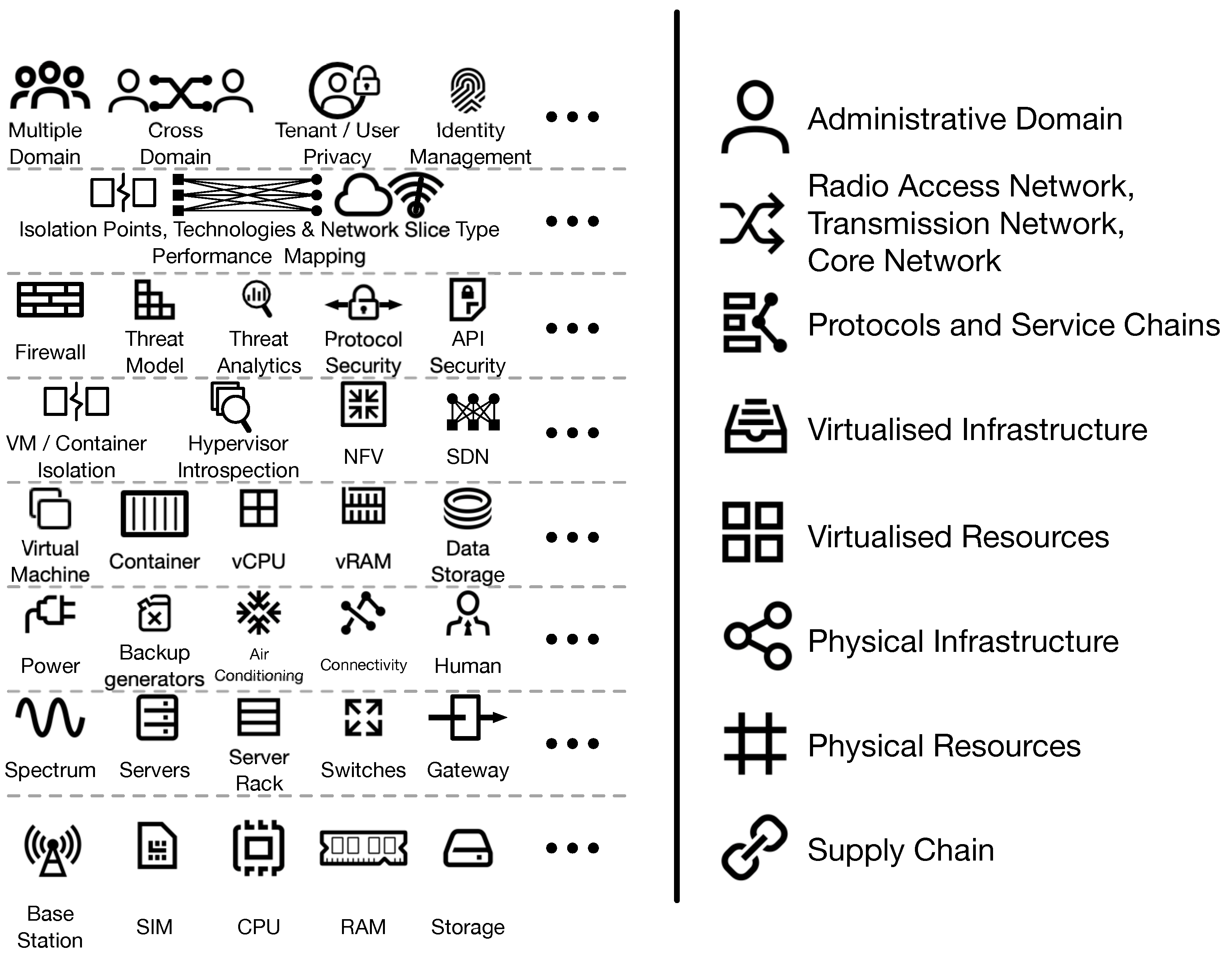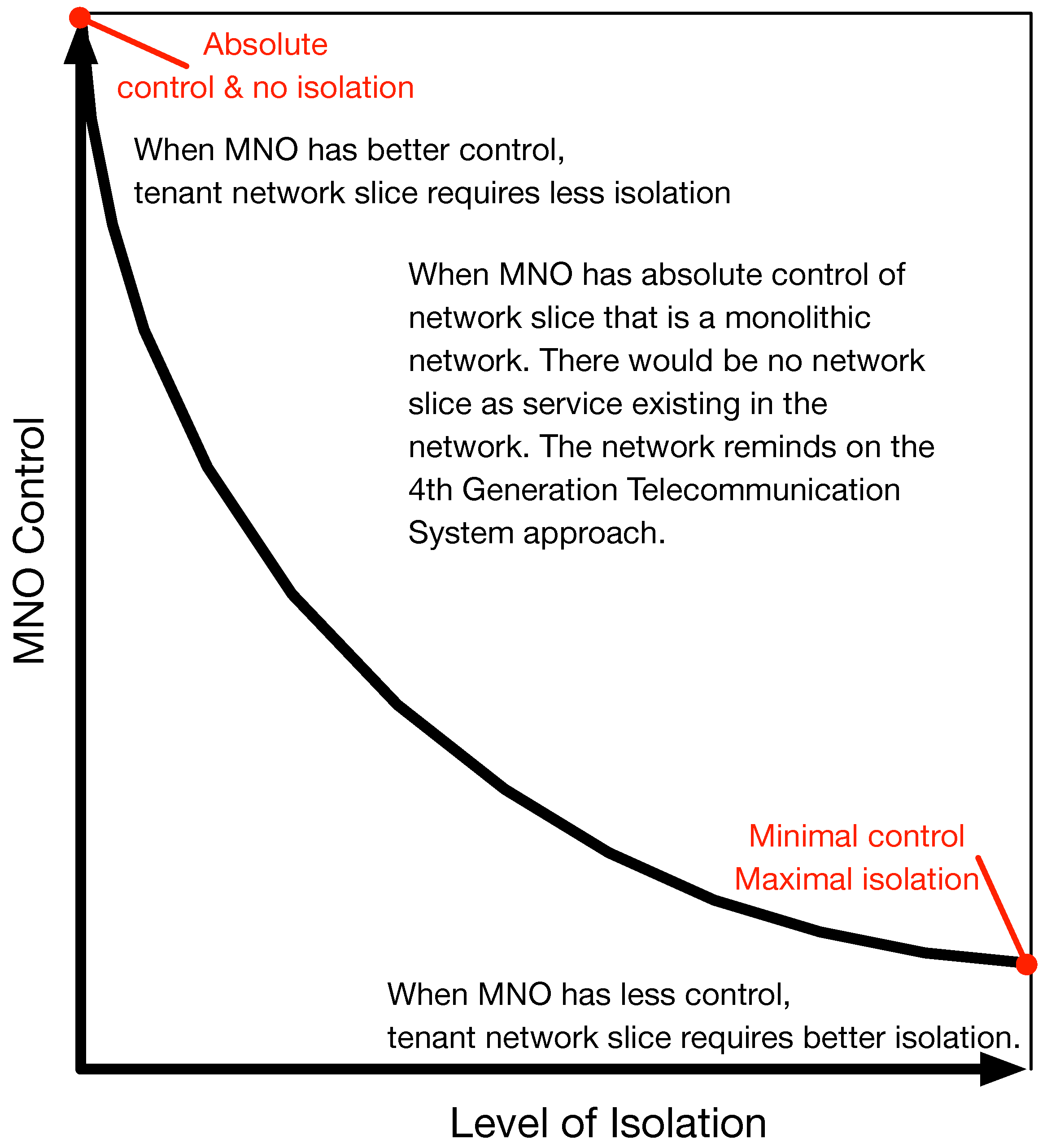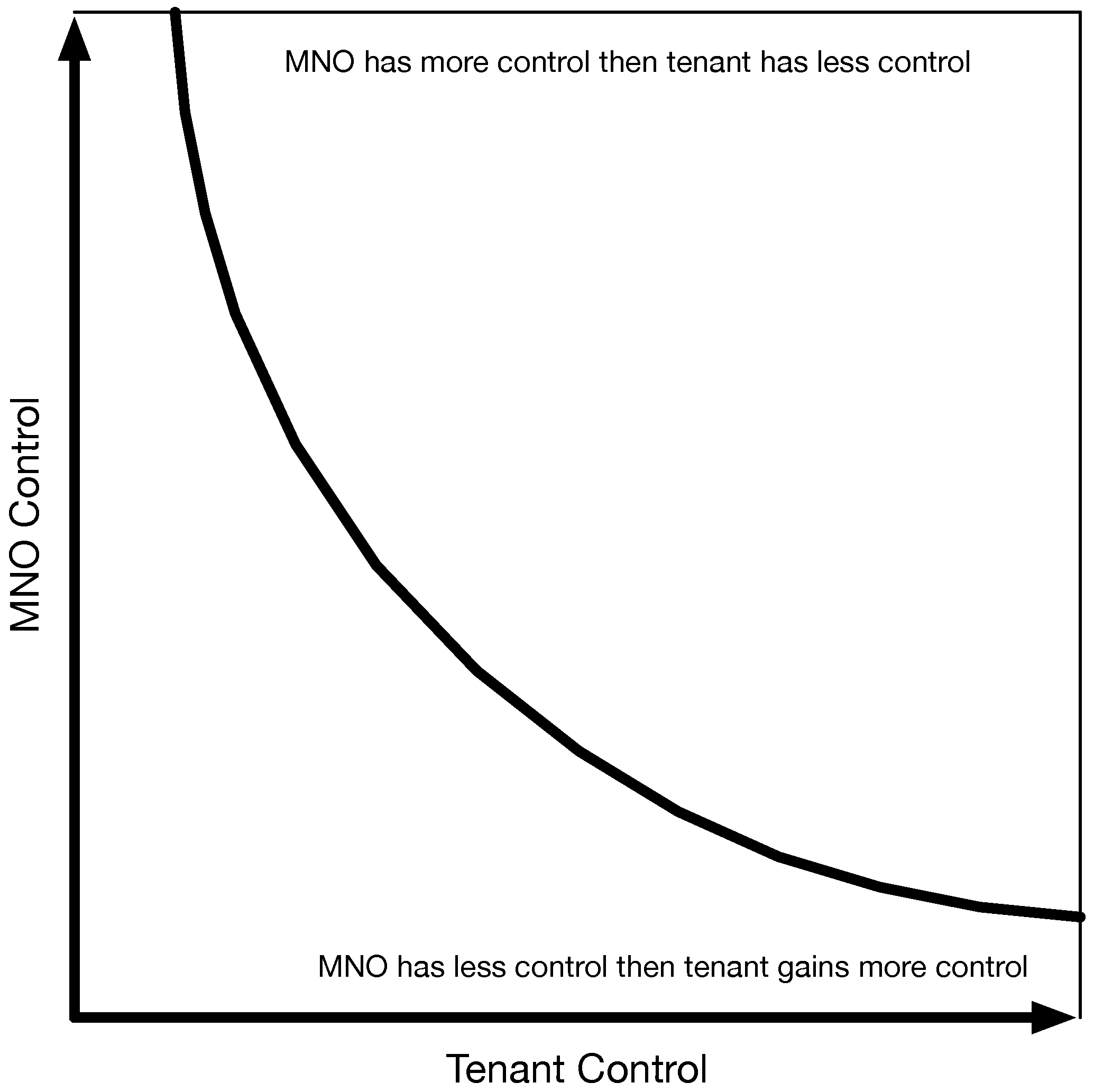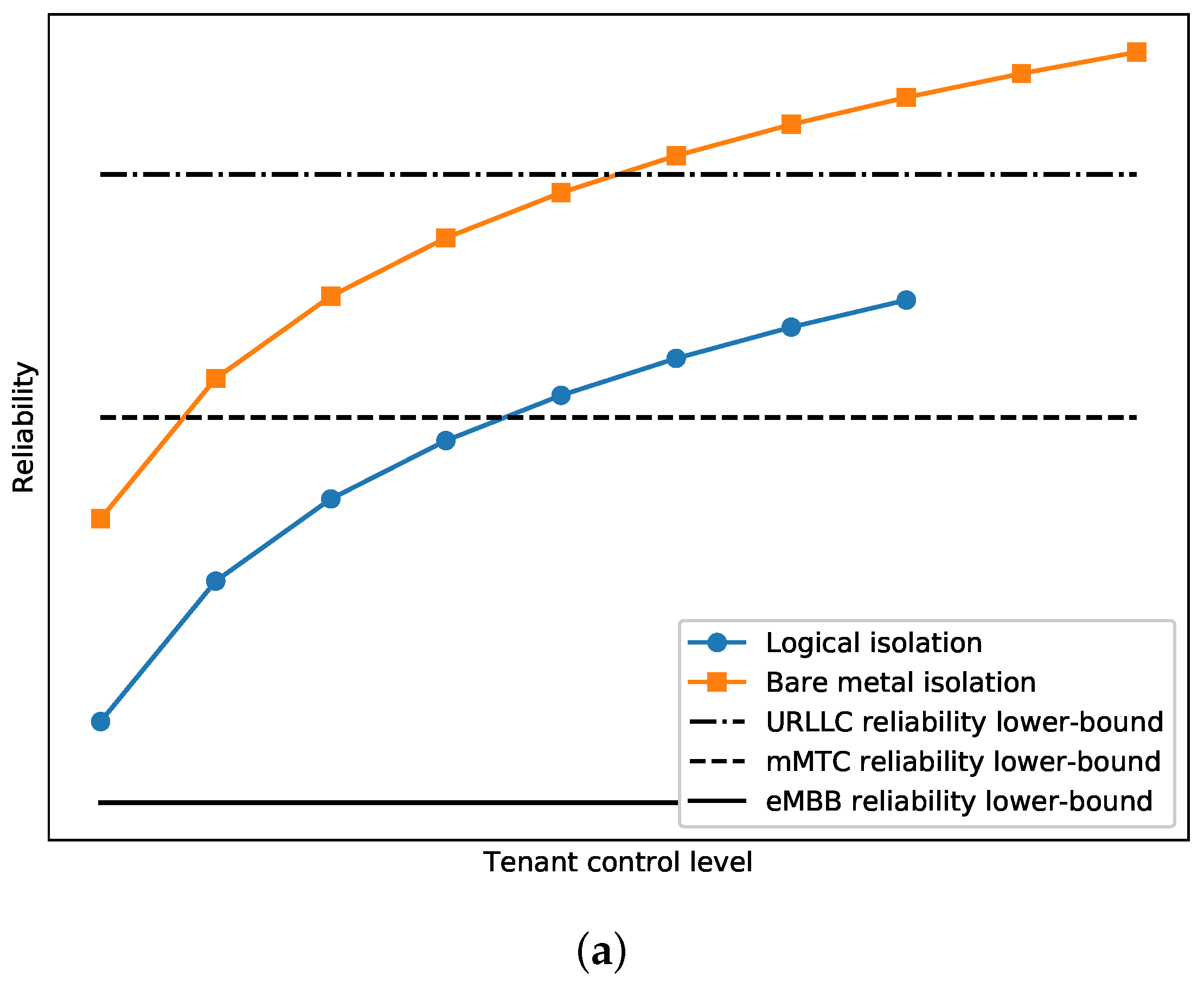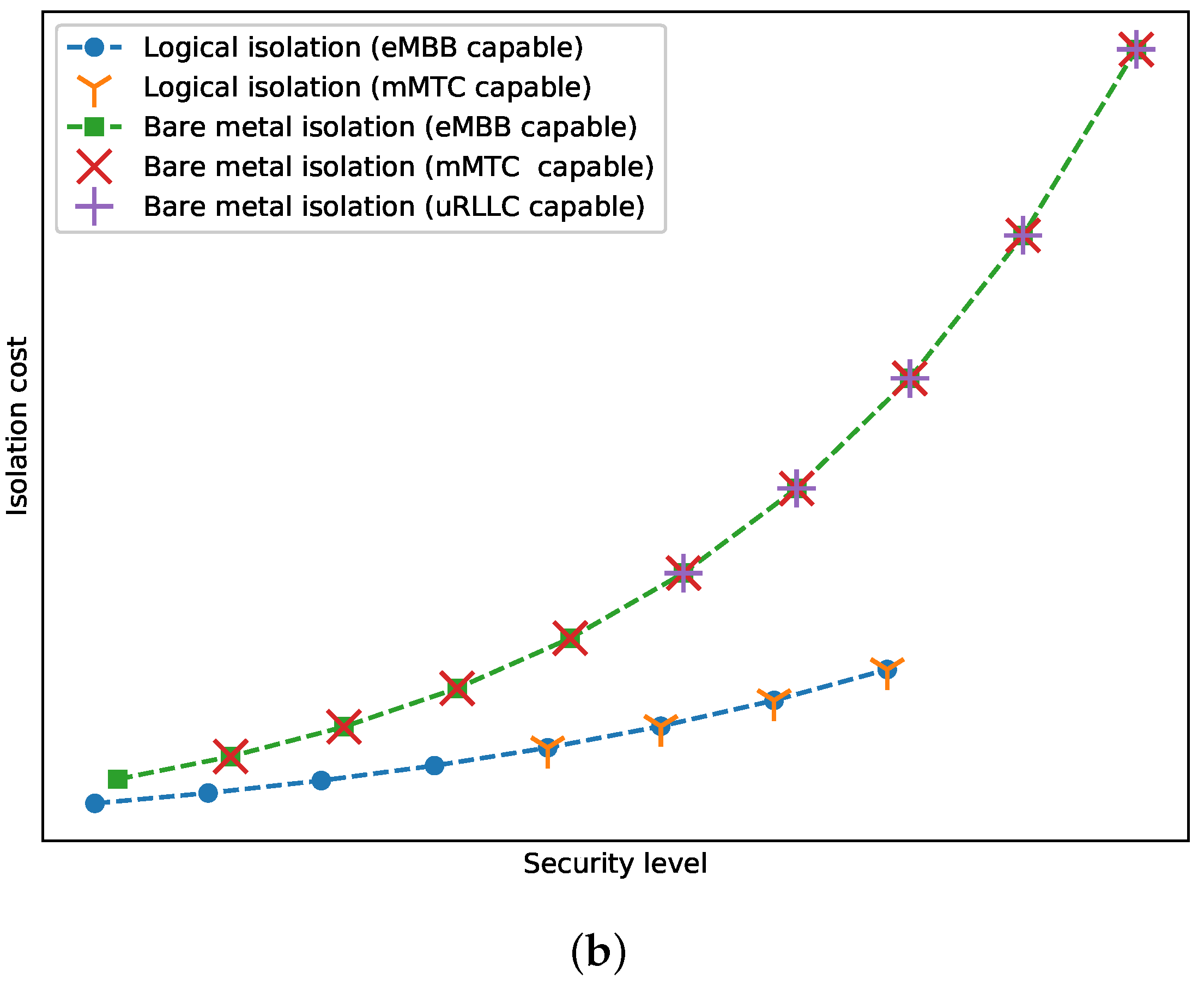NSaaS is set to deliver an on-demand mobile network. It encourages the vertical industry to design and develop their mobile network infrastructures and mobile network services. These mobile network infrastructures and services utilize virtualization, containerization and SDN technologies to increase the flexibility of network provision, deployment and operational models and the business transformation and service agility across multiple mobile networks. In particular, these mobile network infrastructures or services provide network independence and network seclusion, which has been demonstrated with multiple points-of-presence slice segment stitching to construct a network slice and also various resources being flexibly manipulated for a network slice [
12]. Traditionally, the MNO only has a single administrative domain (AD) to manage, a network element and subscriber to protect, an impersonation of a subscriber to prevent, static attack vectors to identify, etc. However, when the NSaaS is deployed, the network flexibility and service agility will lead to a number of new security challenges. In this paper, we provide a comprehensive study of security challenges in four aspects, from identifying the protection assets, preventing attacks and human errors and identifying the right selection of isolation points and different assets required to manage, for ensuring the understanding of NSaaS’ new security challenges and applying the right NSaaS operation protection measures without affecting the network slice service performance requirements that are vitally important in a multi-network slicing environment. It is also critical that the NSaaS security perimeters are adequately defined throughout the entire NSaaS security chain and in the operational level from the radio access network to the transport network and from the transport network to the core network.
3.1. Challenges in Network Slicing Security
In this subsection, the key network slice security challenges are defined in four aspects, which are protection, prevention, identification and management, as summarized in
Table 1.
The protection challenges are raised by concerns about the network infrastructure to support NSaaS, where it shall begin to consider the protection of network infrastructure from static-resource to dynamic-resource network environments. Typically, static resources can be referred to as hardware assets, and dynamic resources can be considered software assets. Furthermore, these software assets can be created at runtime when the network elasticity is triggered by traffic and network services on-demand. Since these runtime software assets can be network slices, virtual network functions and SDN properties that may overload the network and affect the network services availability, we have to protect the network availability, service reliability and company liabilities at all times. In particular, other network services might have a functional error or be compromised, which can possibly affect any other network services’ availability. All these protections shall be considered from the network resilience to the risk assessment of network services.
The prevention challenges are the unauthorized access and inappropriate use of network infrastructure resources, which can be considered the access or usage from the same AD or from other ADs. Traditionally, the MNO only manages a single AD and never has experience managing and authorizing third parties that access various levels of resources based on the service’s level agreement with the tenant. Therefore, preventing cross-ADs resource access is another challenge the MNO is required to manage. In particular, under the virtualized network environment, co-resident attacks may trigger unauthorized access to another virtual machine co-existing under the same bare-metal. Furthermore, the MNO also requires preventing another serious issue in all kinds of systems within the infrastructure, including insider threats. In order to prevent insider threats under such fast evolving and changing network environments, a proper management process and control process has to be applied on top of traditional approaches. For example, ISO/IEC 27001 has a series of control processes to ensure the information security management in securing the system. We often face an unknown threat when network automation is applied to a virtualized network infrastructure environment because there is a possibility that an attacker may be inappropriately manipulating network resources via auto-optimization and auto-reconfiguration. Therefore, we shall apply zero trust to prevent auto-manipulation of network resources.
The identification of security threat challenges is typically an essential task for the MNO before network deployment. Usually, the MNO will establish security control policies appropriately, which is not just based on the local regulations’ requirements and international benchmark approaches [
13] but also the demand for adapting the best practice from the industry. Therefore, identifying the security control policies for deploying NSaaS requires considering the security policies under the flexible network and dynamic network runtime environments. It cannot simply apply black-box approaches that will eventually expose various unidentified attack vectors and vulnerable loopholes since the common practice of identifying the attack vectors or conducting the risk assessments requires an existing network environment. In particular, attack vectors will not be straightforward without an existing network infrastructure and services environment. Even though the flexible network infrastructure is unpredictable for managing the resources, we shall clearly state the security policies when applying network elasticity. Furthermore, we also have to identify the adequate physical and logical isolation points for each of the network slices to protect the service’s availability, set the security perimeters and provide appropriate security measures in the future.
In terms of the network management challenges, we have a number of items that must be seriously considered. The MNO shall provide policies to manage the unknown ADs and the virtual environment visibility. In particular, the virtual environment visibility can be managed by different technological techniques, e.g., microsegmentation, hypervisor firewall, etc. These techniques can increase the visibility but also require a substantial amount of knowledge to manage them. On the other hand, under NSaaS, we have many tenants that need to be managed. For example, a tenant’s identity, access and privacy need to be properly managed. Furthermore, the MNO shall provide a privacy scheme or guideline for tenants to manage their subscribers in order to reduce the risk of the network.
The above four aspects can assist the MNO in securely operating the NSaaS. Therefore, we propose to plan and provide a precise policy of control to fulfill these aspects as the basic requirements.
3.2. Decomposition of Network Slicing Security Complexity
In this subsection, we present a multi-level model of the network slicing security decomposition. Basically, this model also represents a network construction sequence that starts from deciding the type of devices available in the supply chain. Once installed in the network, those devices become physical resources that formulate the infrastructure. In order to be fully utilized, they can be transferred into virtual resources by applying virtualization and containerization technologies. Consequently, those formulated virtual resources should be managed by an information management platform, e.g., NFV. After the physical and virtual infrastructures are fully established, we start to consider the protocol and service chain’s protection methodologies and the appropriate isolation points in the network slice. Finally, from the MNO’s point of view, it is essential to consider a network slice platform to manage the network slice tenants by means of tenant identities, access rights, services, etc. Note that the above description is simplified regarding the deployment consideration and sequence of architectural design decisions. Furthermore, between every two layers, there is a tight relationship and logical link in the deployment of a network slice. Furthermore, each of the layers and elements has a specific protection method, which we are going to discuss in this subsection.
As illustrated in
Figure 1, the lowest three levels in our model are inherited from the traditional network security model, which concerns the fundamental telecommunication equipment supply chain security, physical resource security and physical infrastructure, respectively. The fourth layer to the top layer are the logical and information security concerns, which are considered to deal with a wider attack surface every layer. Furthermore, the complexity of defense in each layer will also increase layer-by-layer from the bottom to the top layer. We further describe each of the layer’s characteristics in the following.
Layer I Supply Chain—Usually, it is a first line of defense and is considered a physical active electronic component and passive electronic component. Software components or entities shall be included within the supply chain. Those components’ software is often employed with malicious code. Therefore, we have to have certain level of control over the supply chain when deploying NSaaS. ISO 28000 specification has a well-established supply chain security management control framework that can be applied. NIST has also suggested supply chains’ life-cycle management [
14]. Furthermore, supply chain security management is not just to deliver control and assurance to the overall system, it also requires defining the level of control processes, certifications of the product within the best practice in the current time and the trustworthiness of the protocol applied to test the products. GSMA provides a supply chain toolbox to give a guideline of this first line of defense [
15], and NSCS also provides 12 principles to ensure the first line of defense under control within the appropriate stage of the overall supply chain [
16].
Layer II Physical Resources—Often, the MNO unifies the physical network elements and license’s components as physical resources that will increase the flexibility of the overall mobile network infrastructure and refine the productivity by applying different service management methodologies. Furthermore, the MNO also constantly searches various methods and techniques to fully utilize all available resources in their network infrastructure. Furthermore, by deploying a network slice, the second line of defense is to manage different types of physical resources that apply to a particular network slice. For example, a critical infrastructure network slice can only be deployed in a few specific locations with selected spectrum threats, and the local breakout may also require being deployed with an air-gap isolated server rack, switch and the internet gateway.
Layer III Physical Infrastructure—Facility infrastructure resiliency gives service reliability to the MNO’s mobile network infrastructure. There are a number of international data center control frameworks [
17] to protect this third line of the network slice’s defense service’s availability and reliability. For example, a utility smart grid network slice may request a wide area deployment and require a certain level of service availability and reliability. Hence, the MNO may need to pick the right level of the data center for such network slice deployment. Often, the mobile network infrastructure is constructed by different data centers, which different data center management teams and companies are often employed to manage. In maintaining the data center service reliability and ensuring the different levels of data center security, data center security is not only facility security but also includes identity and access management, etc.
Layer IV Virtual Resources—Generally, network slicing is based on virtualization and containerization technologies as its foundation. Network slices can be constructed under virtual machines, containers or a combination of virtual machines and containers, and each network slice can be specifically restricted on the number of vCPU or vRAM and the type of storage. The MNO requires managing its virtual resources so that it does not exceed the maximum level of physical resource limitation and cause service interruptions.
Layer V Virtual Infrastructure—The level of complexity in this layer has been significantly increased. We have to consider the implementation virtual machine and container isolation techniques to avoid co-residency attack. The typical technique that would be applied is the hypervisor introspections or serverless container isolation technique at the kernel level. The virtualized infrastructure can have an access control list for a particular application to secure the entire network segment using microsegmentation, which automatically applies network segregation. Therefore, the virtualization and containerization network security would be the main consideration in this layer since this layer’s defense is across different areas of technology implementation, from application to virtual network segmentation and from infrastructure access control to the CPU firmware trust model. All these techniques are trying to keep network slices isolated from each other.
Layer VI Protocol and Service Chain—In this layer, a formulated network slice shall have a specific service to deliver. Usually, the MNO formulates those services that may use a service chain approach. Service chains are often in a sequential manner of network functions that can also split into multi-locations, and the traffic will propagate from one network location to another in a specific sequence. Due to the network service chain’s sequential structure, we can collect network intelligence data that can be used to increase the virtual network infrastructure visibility and threat intelligence protection on different levels of the network slice’s defense. However, we have to avoid the inappropriate virtual resource manipulations; therefore, we can use the appropriate security protocol and API security to prevent malicious manipulations.
Layer VII Radio Access Network, Transmission Network and Core Network—When deploying a network slice, we need to identify various isolation points as network defense perimeters, where different isolation techniques can be applied. Those isolation points must be carefully selected; otherwise, the service performance can be easily affected. Therefore, mapping the isolation points with adequate technology under different network slice types is an important process in deploying network slices.
Layer VIII Administrative Domain—Consequently, there is a possibility that the tenant may have purchased multiple network slices across different MNOs, and the tenant may share all resources across multiple network slices. Therefore, the MNO or network slice service provider requires protecting each AD’s user and tenant privacy and must manage users’ and tenants’ identities who accesses the appropriate AD.
The above multi-layer approach can assist the network slice’s service provider or MNO to distinguish and differentiate the level of managing the NSaaS platform and to protect the overall MNO network service availability. After resolving the network slice complexity in layers, we shall focus on the practical deployment of NSaaS, which focuses on the defense of three domains in the data center: radio access network, transport network and core network.
3.3. Precision of Network Slice Isolation Point
Identifying an adequate network slice isolation point and applying the right network slice isolation mechanism and policy at those isolation points are the main challenges in deploying multi-network slicing to a mobile operator network. Network slices are designed to support the co-existence of multiple tenants on an MNO physical network with independent, isolated and fully secured network services. Furthermore, one tenant would not know another tenants’ existence in the network. A similar strategy has been proposed on the Internet to isolate services or applications using a service-oriented architecture [
18]. However, it might need abnormal detection to protect the behavior of the network slice from faults, e.g., an inappropriate selection of isolation points. In the case of such faults, the anomaly detection algorithm can also be invoked to obtain the score of isolation points behavior [
19], which may be further exploited by machine learning techniques to isolate the faults [
20] and to model the slice behavioral patterns under a particular setup of isolation points.
GSMA has defined eight types of network slice use cases, and each of the network slice types could have different network configurations, network performance requirements, traffic criteria and security control, etc. All these characteristics would ultimately lead to delivering the service experience to the subscriber and fulfilling the network slice’s Service Level Agreement (SLA) securely [
21]. In particular, multi-network slice deployment involves different network technologies, resource migration and resource optimization at the runtime. Either an inappropriate selection of the isolation points or wrongly applying an isolation mechanism and policy in each of the isolation points can cause network performance degradation or service delivery interruption after resource optimization and migration. Therefore, we shall identify each of the possible isolation points and adequate security mechanisms and policies applied to those isolation points. By appropriately specifying these features, it helps not only by securing the network slice but also by enhancing the network performance without affecting the subscriber’s experience or violating the SLA.
Figure 2,
Figure 3,
Figure 4 and
Figure 5 provide illustrations of some phenomena when deploying a network slice.
Figure 2 is divided into three parts: on the right and left sides, two options are illustrated where the tenant requests for a network slice with the most tenant control and minimal influence from the MNO (left) or balanced control shared between the tenant and the MNO (right), respectively. In the earlier case, the MNO only provides physical resources (e.g., spectrum etc.); in the latter case, several layers of the protocol stack and some specific network functions are defined and controlled by the MNO. In the middle,
Figure 2 shows how the level of isolation matters to the cost of deployment when considering network slice isolation. In particular,
Figure 2 indicates the minimal and maximal cost of isolation that would start on a positive manner due to the physical resources (e.g., spectrum etc.) that belong to the MNO. The graph also indicates the characteristics of the isolation relationship in between the level of control a tenant can gain when deciding to purchase a network slice. Furthermore, the graph indicates that is not directly proportional to each other due to the vast number of isolation techniques that can be applied to deliver similar protection.
Figure 3 provides an overview of controlling a network slice by the tenant. When the tenant has minimal control of a network slice, which implies the tenant fully relies on the MNO to manage the network slice, and the MNO has less responsibility to apply isolation in order to protect the network slice. On the other hand, when the tenant has maximal control of the network slice, the MNO is responsible for applying isolation to the network slice for protecting the other tenant’s privacy.
Figure 4 reflects the control of the MNO, which is correlated to
Figure 3. Furthermore,
Figure 4 indicates when the MNO has absolute control of the network slice, which is a monolithic network. There would be no NSaaS existing in the network. The network relies on the fourth-generation telecommunications system.Finally,
Figure 5 shows the exclusive relationship between the MNO control and tenant control on any certain network slice. It shall be noted that
Figure 2,
Figure 3,
Figure 4 and
Figure 5 show no quantitative results but only qualitative relations among the level of isolation, slicing cost and control levels, which can be straightforwardly derived from the control-sharing mechanism and the cost budget of network slice isolation.
